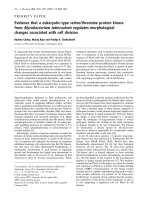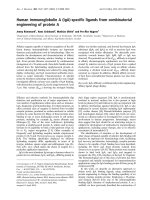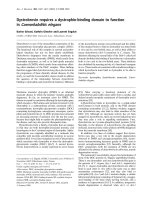Báo cáo y học: "Rheumatoid cachexia: a complication of rheumatoid arthritis moves into the 21st century" potx
Bạn đang xem bản rút gọn của tài liệu. Xem và tải ngay bản đầy đủ của tài liệu tại đây (46.55 KB, 2 trang )
Available online />Page 1 of 2
(page number not for citation purposes)
Abstract
Rheumatoid cachexia, loss of muscle mass and strength and
concomitant increase in fat mass, is very common in patients with
rheumatoid arthritis (RA). Despite great advances in the treatment
of RA, it appears that rheumatoid cachexia persists even after joint
inflammation improves. Rheumatoid cachexia may be an important
risk factor for cardiovascular disease and excess mortality in RA. In
this issue of Arthritis Research & Therapy, Elkan and colleagues
demonstrate a link between rheumatoid cachexia and metabolic
syndrome, further reinforcing the need for therapy directed beyond
inflammation and at the metabolic consequences of RA.
This issue of Arthritis Research & Therapy includes an
important article on rheumatoid cachexia by Elkan and
colleagues [1] demonstrating that cachexia remains common
in rheumatoid arthritis (RA) and is associated with a higher
prevalence of metabolic syndrome and hypertension, which
may contribute to the excess mortality of RA. Weight loss and
muscle wasting are common features of untreated RA, as
originally described by James Paget in the 19th century [2].
However, rheumatoid cachexia, from the Greek meaning ‘bad
condition’, was not recognized as a common problem among
patients with RA until relatively recently [3]. Rheumatoid
cachexia refers to the loss of fat-free mass, predominantly
skeletal muscle, that occurs in RA. Loss of body weight does
not always occur; in fact, loss of body fat-free mass is often
accompanied by increased fat mass and stable body weight.
Rheumatoid cachexia may affect up to two-thirds of all
patients with RA [3,4]. Elkan and colleagues, using a more
conservative definition of both low fat-free mass and high fat
mass, found that about a quarter of their patients were
cachectic.
Evidence from cancer, heart failure, and HIV infection strongly
points to weight loss as an independent predictor of poor
outcome (reviewed in [5]). The average loss of fat-free mass
among patients with RA is between 13% and 15% –
approximately one-third of the maximum survivable loss of fat-
free mass [6]. Loss of fat-free mass and higher fat mass are
each associated with greater disability in RA [7], and low
body weight (that is, both fat and fat-free tissue) in patients
with RA is associated with threefold higher mortality [8].
Thus, rheumatoid cachexia may be an important contributor
to increased morbidity and premature mortality in RA.
A number of factors are likely involved in the pathogenesis of
rheumatoid cachexia, including ‘sarcoactive’ cytokines,
energy expenditure, protein metabolism, physical activity
levels, and hormones. For example, the inflammatory
cytokines tumor necrosis factor (TNF)-α and IL-1β are
centrally involved in the pathogenesis of RA, but, in addition,
these cytokines exert a powerful influence on whole-body
protein and energy metabolism. Other sarcoactive molecules
include IL-6, IFN-γ, transforming growth factor-β1, and MyoD
[9]. Patients with RA have higher rates of whole-body protein
breakdown compared with young and elderly healthy
subjects, and, furthermore, protein breakdown is directly
associated with TNF-α production by peripheral blood
mononuclear cells [10]. More recent research has suggested
that skeletal muscle protein loss is dependent upon the
signaling activities of both TNF-α and IFN-γ, and that nuclear
factor kappa B activity is needed for these cytokines to
induce muscle damage [11]. Nevertheless, although anti-TNF
therapy improves insulin resistance in RA, it does not seem to
reverse rheumatoid cachexia [12].
Patients with RA also have reduced physical activity as a
result of joint pain and stiffness, metabolic changes leading to
loss of muscle mass and strength, and simple disuse,
perhaps related to general cautiousness with regard to
physical activity. While the role of the growth hormone (GH)-
Editorial
Rheumatoid cachexia: a complication of rheumatoid arthritis
moves into the 21st century
Ronenn Roubenoff
1,2
1
Immunology R&D, Biogen Idec, Inc., Cambridge, MA 02142, USA
2
Tufts University and Tufts Medical Center, Boston, MA 02111, USA
Corresponding author: Ronenn Roubenoff,
Published: 27 April 2009 Arthritis Research & Therapy 2009, 11:108 (doi:10.1186/ar2658)
This article is online at />© 2009 BioMed Central Ltd
See related research article by Elkan et al., />GH = growth hormone; IFN = interferon; IL = interleukin; RA = rheumatoid arthritis; TNF = tumor necrosis factor.
Arthritis Research & Therapy Vol 11 No 2 Roubenoff
Page 2 of 2
(page number not for citation purposes)
insulin-like growth factor 1 axis in altering muscle mass and
strength during healthy aging is not fully understood, GH is
known to decline with aging, and has been suggested to play
a role in the pathogenesis of sarcopenia (age-related muscle
loss) [13]. However, persistent GH deficiency does not
appear to be the cause of rheumatoid cachexia [13]. Like
GH, insulin is a potent anabolic hormone, and insulin
resistance has been shown to occur in inflammatory arthritis
[14]. It is possible that the metabolic milieu created by a state
of insulin resistance may permit cytokine-driven muscle loss,
although this remains speculative.
Elkan and colleagues [1] also made two other important
contributions to our understanding of rheumatoid cachexia.
First, by demonstrating that dietary fat intake was not an
independent risk factor for this complication, they added
support to the notion that cachexia cannot be cured by
dietary intervention alone. Second, the demonstration of
increased metabolic syndrome in patients with rheumatoid
cachexia underlines the complex interplay between fat mass,
lean mass, and insulin resistance in RA. In addition, Elkan and
colleagues’ finding of lower levels of potentially protective
antibodies against cardiovascular disease offers an intriguing
hypothesis as to the mechanism of accelerated athero-
sclerosis in RA. As rheumatologists, we all properly focus on
the joints and their protection in RA, but we should step back
and evaluate the muscle and fat mass as well, and seek to
protect our patients from the metabolic complications of RA
in addition to its rheumatic sequelae.
Competing interests
RR is an employee of Biogen Idec, Inc. a biotechnology
company that manufactures rituximab, which is approved for
treatment of lymphoma and rheumatoid arthritis
References
1. Elkan A-C, Hakansson N, Frostegard J, Cederholm T, Hafstrom I:
Rheumatoid cachexia is associated with dyslipidemia and low
levels of atheroprotective natural antibodies against phos-
phorylcholine but not with dietary fat in patients with rheuma-
toid arthritis: a cross sectional study. Arthritis Res Therapy
2009, 11:R37.
2. Paget J: Nervous mimicry of organic diseases. Lancet 1873, 2:
727-729.
3. Roubenoff R, Roubenoff R, Ward L, Holland S, Hellmann D:
Rheumatoid cachexia: depletion of lean body mass in
rheumatoid arthritis. Possible association with tumor necrosis
factor. J Rheumatol 1992, 19:1505-1510.
4. Engvall I-L, Elkan A-C, Tengstrand B, Cederholm T, Brismar K,
Hafstrom I: Cachexia in rheumatoid arthritis is associated with
inflammatory activity, physical disability, and low bioavailable
insulin-like growth factor. Scand J Rheumatol 2008, 37:321-
328.
5. Roubenoff R, Kehayias J: The meaning and measurement of
lean body mass. Nutr Rev 1991, 46:163-175.
6. Roubenoff R, Roubenoff RA, Cannon JG, Kehayias JJ, Zhuang H,
Dawson-Hughes B, Dinarello CA, Rosenberg IH: Rheumatoid
cachexia: cytokine-driven hypermetabolism accompanying
reduced body cell mass in chronic inflammation. J Clin Invest
1994, 93:2379-2386.
7. Giles J, Bartlett S, Anderson R, Fontaine K, Bathon J: Association
of body composition with disability in rheumatoid arthritis:
impact of appendicular fat and lean tissue mass. Arthritis Care
Res 2008, 59:1407-1415.
8. Kremers H, Nicola P, Crowson C, Ballman K, Gabriel S: Prognos-
tic importance of low body mass index in relation to cardio-
vascular mortality in rheumatoid arthritis. Arthritis Rheum
2004, 50:3450-3457.
9. Zoico E, Roubenoff R: The role of cytokines in regulating
protein metabolism and muscle function. Nutr Rev 2002, 60:
39-51.
10. Rall LC, Rosen CJ, Dolnikowski G, Hartman WJ, Lundgren N,
Abad LW, Dinarello CA, Roubenoff R: Protein metabolism in
rheumatoid arthritis and aging: Effects of muscle strength
training and tumor necrosis factor-alpha. Arthritis Rheum
1996, 39:1115-1124.
11. Guttridge D, Mayo M, Madrid L, Wang C-Y, Baldwin A: NF-
kappaB-induced loss of MyoD messenger RNA: possible role
in muscle decay and cachexia. Science 2000, 289:2363–2366.
12. Metsios GS, Stavropoulos-Kalinoglou A, Douglas KM, Koutedakis
Y, Nevill AM, Panoulas VF, Kita M, Kitas GD: Blockade of tumor
necrosis factor-alpha in rheumatoid arthritis: effects on com-
ponents of rheumatoid cachexia. Rheumatology 2007, 46:
1824-1827.
13. Rall LC, Walsmith JM, Snydman L, Reichlin S, Veldhuis JD,
Kehayias JJ, Abad LW, Lundgren NT, Roubenoff R: Cachexia of
rheumatoid arthritis is not explained by decreased growth
hormone. Arthritis Rheum 2002, 46:2574-2577.
14. Chung CP, Oeser A, Solus JF, Gebretsadik T, Shintani A, Avalos I,
Sokka T, Raggi P, Pincus T, Stein CM: Inflammation-associated
insulin resistance. Arthritis Rheum
2008, 58:2105-2112.









